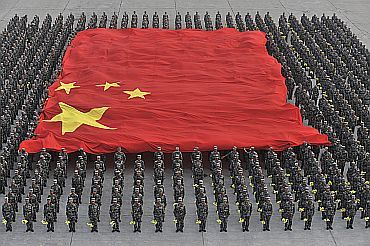Assuming the official defence allocations represent the true picture, the $142 billion figure still represents a phenomenal increase and surpasses that of Japan ($42 billion), India ($40 billion), South Korea ($33 billion) and several other Asian countries put together and shows that China is flexing its military muscle, says Srikanth Kondapalli.

The latest hike in China's defence budget allocations to about $142 billion represent double digit increase -- a feature consistently maintained for the last more than two decades to make China the second largest defence spender in the world after the United States.
Assuming the official allocations represent the true picture -- and cooking up the books in China had been rampant with its auditing system still rudimentary in nature -- the $142 billion figure still represents a phenomenal increase and surpasses that of Japan ($42 billion), India ($40 billion), South Korea ($33 billion) and several other Asian countries put together.
Firstly, it is only recently that China discarded the 'incremental regulatory' process and adopted a 'zero-based' budgeting system, the efficiency of which is tested repeatedly with high-level corruption scandals reported from the military sector as well as lack of a strong vigilance system.
China still lacks a robust and unified financial management system that could efficiently tabulate disbursement of finances related to military equipment procurement from domestic or foreign vendors, production and management or logistics. As a result, huge gap in effective auditing procedures is visible in China's armed forces today.
Thus, the daughter of former vice chairman of the Central Military Commission -- the highest military body in China -- General Xu Caihou reportedly received a debit card worth 20 million yuan (about Rs 20 crore/Rs 200 million).
The top official of the General Logistics Department of China's military -- that is supposed to partly involve in the budgetary process -- General Gu Junshan amassed several truck loads of gold bars, contraband items and foreign currency. Sixteen other high ranking military officials recently were investigated for 'discipline violation' charges.
Secondly, China's defence budgetary allocations previously were conditioned by a bland method of 'generalised' announcement without mentioning allocations to specific sectors. While 'categorised' budgetary allocations were outlined in the last five years, these are still several lacunae in these announcements often with a sleight of hand.
Thus through the recent white papers on defence, China mentioned predominantly the revenue (salaries, maintenance, etc) rather than capital expenditures (military equipment procurement).
Specifically, military equipment imports from Russia or Israel are hardly mentioned in the final tally. Sector-wise -- army, navy, air force and strategic rocket forces -- were only recently announced, even though for these sectors as well a clear picture is still not available.
According to some estimates, the real defence budget of China could be as much as $300 billion.
Thirdly, Premier Li Keqiang in his work report to China's parliament stated the philosophy behind the defence budget by reiterating the principle of 'coordinated' development between the civilian economy and the defence sector. That is, if the civilian economy grows, the defence sector could look up for enhanced allocations.
As the civilian economy for the last four years was reduced to single digits (under 8 per cent a year) as the 'new normal' growth figures, the defence sector should have also seen a dip.
However, for 2015, the defence sector still managed to maintain double digit increase, although reduced from 12.2 to over 10.1 percent.
Fourthly, the consistent and increased allocations to the defence sector has been justified by Chinese Ambassador to the United Kingdom Fu Ying so as to keep up pace with the advanced militaries of the world, specifically the United States.
While in several sectors China's military lags behind the US forces, it is by no means a push over.
Indeed, of late by adopting anti-access and area denial strategies, China's navy has kept at bay the US forces away from South China and the Yellow Sea.
Also, by sending 18 naval contingencies to the Gulf of Aden since 2008, China had successfully tested its out of the area air and sea lift capabilities.
By imposing an air identification zone in the East China Sea and engaging Japanese forces over 900 times last year China had sent signals of contestation in the region.
Likewise, by sending submarines to Sri Lanka last year, in addition to the on-going border transgressions, China continues to test Indian resolve. With the adoption of the continental and maritime Silk Roads, China's defence expenditure to protect these areas will further increase in the coming years.
Finally, between the avowed national security goals and China's leaders's avowed statements there is an increasing chasm. While the last white paper on defence in 2012 stated that China is gearing up to counter 'three evils' -- China's code words to counter internal security challenges -- the defence hike indicates to catering for external contingencies.
All in all then, with less than three times the officially stated Chinese defence allocations and clearly no intent to match China's figures, India has to find solutions in a mix of diplomacy, dialogue and self-help.
Srikanth Kondapalli is Professor in Chinese Studies at Jawaharlal Nehru University, New Delhi.











 © 2025
© 2025